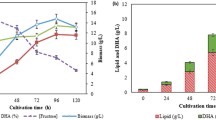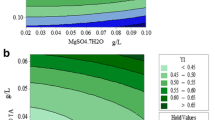Abstract
Optimization of the medium components which enhance carotene production by Blakeslea trispora was achieved with the aid of response surface methodology. In the first step, a central composite design was employed to achieve the highest carotene concentration at optimum values of the process variables, i.e., linoleic acid, Span 20, and butylated hydroxytoluene (BHT), added in the basal medium. The fit of the model was found to be significant. The production medium to achieve the highest carotene concentration (139.0 ± 4.5 mg/g dry biomass) was composed of the basal medium supplemented with linoleic acid (21.3 g/l), Span 20 (16.0 g/l), and BHT (4.7 g/l). The results show that the optimization strategy led to an increase in carotene production by 35-fold. The carotenes content in Β. trispora were β-carotene (45%), γ-carotene (31%), and lycopene (24%). In the second optimization step, the production medium was supplemented with different trace elements which significantly affect carotene production (i.e., CuSO .4 5H2O, FeCl .3 6H2O, and Co(NO3)2.6H2O). The experimental validation showed that the model was effective. The optimized medium for enhanced carotene concentration consists of the production medium supplemented with 395.64 mg/l CuSO .4 5H2O, 10.0 mg/l FeCl .3 6H2O, and 1.12 mg/l Co(NO3) .2 6H2O. Practical validation of the above optimum medium gave carotene production 154.0 ± 5.0 mg/g dry biomass, which is 10% higher than the concentration of carotenes in the production medium. In this case, the carotenes consisted of β-carotene (37%), γ-carotene (47%), and lycopene (16%). Thus, the addition of trace elements to the production medium increased slightly the concentration of carotenes, but changed mainly the composition of the carotenes to a drastic increase of γ-carotene concentration.



Similar content being viewed by others
References
Aksu, Z., & Tugba Eren, A. (2005). Carotenoids production by the yeast Rhodotorula mucilaginosa: Use of agricultural wastes as a carbon source. Process Biochemistry, 40, 2985–2991.
Bhosale, P. (2004). Environmental and cultural stimulants in the production of carotenoids from microorganisms. Applied Microbiology and Biotechnology, 63, 351–361.
Buzzini, P., & Martini, A. (1999). Production of carotenoids by strains of Rhodotorula glutinis cultured in raw materials of agro-industrial origin. Bioresource Technology, 71, 41–44.
Choudhari, S., & Singhal, R. (2008). Media optimization for the production of β-carotene by Blakeslea trispora: A statistical approach. Bioresource Technology, 99, 722–730.
Choudhari, S., Ananthanarayan, L., & Singhal, R. (2008). Use of metabolic stimulators and inhibitors for enhanced production of β-carotene and lycopene by Blakeslea trispora NRRL 2895 and 2896. Bioresource Technology, 99, 3166–3173.
Dominguez, A., Deive, F. J., Sanroman, M. A., & Longo, M. A. (2003). Effect of lipids and surfactants on extracellular lipase production by Yarrowia lipolytica. Journal of Chemical Technology and Biotechnology, 78, 1166–1170.
Goksungur, Y., Mantzouridou, F., & Roukas, T. (2002). Optimization of the production of β-carotene from molasses by Blakeslea trispora: A statistical approach. Journal of Chemical Technology and Biotechnology, 77, 933–943.
Goksungur, Y., Mantzouridou, F., Roukas, T., & Kotzekidou, P. (2004). Production of β-carotene from beet molasses by Blakeslea trispora in stirred-tank and bubble column reactors. Applied Biochemistry and Biotechnology, 112, 37–54.
Goldberg, I., & Stieglitz, B. (1985). Improved rate of fumaric acid production by Tweens and vegetable oils in Rhizopus arrhizus. Biotechnology and Bioengineering, 27, 1067–1069.
Govind, N. S., Amin, A. R., & Modi, V. V. (1982). Stimulation of carotenogenesis in Blakeslea trispora by cupric ions. Phytochemistry, 21, 1043–1044.
Gurr, M. I., & James, A. T. (1980). Lipid biochemistry: An introduction (3rd ed.). London: Chapman and Hall.
Malisorn, C., & Suntornsuk, W. (2008). Optimization of β-carotene production by Rhodotorula glutinis DM28 in fermented radish brine. Bioresource Technology, 99, 2281–2287.
Malisorn, C., & Suntornsuk, W. (2009). Improved β-carotene production of Rhodotorula glutinis in fermented radish brine by continuous cultivation. Biochemical Engineering Journal, 43, 27–32.
Mantzouridou, F., & Tsimidou, M. (2007). Carotenoid pattern in Blakeslea trispora grown on oil-enriched substrates with regard to triacylglycerol species accumulation. European Journal of Lipid Science and Technology, 109, 3–10.
Mantzouridou, F., Roukas, T., & Kotzekidou, P. (2002a). Optimization of β-carotene production from synthetic medium by Blakeslea trispora in a stirred tank reactor and relationship between morphological changes and pigment formation. Food Biotechnology, 16, 167–187.
Mantzouridou, F., Roukas, T., & Kotzekidou, P. (2002b). Effect of the aeration rate and agitation speed on β-carotene production and morphology of Blakeslea trispora in a stirred tank reactor: Mathematical modeling. Biochemical Engineering Journal, 10, 123–135.
Mantzouridou, F., Roukas, T., & Kotzekidou, P. (2004). Production of beta-carotene from synthetic medium by Blakeslea trispora in fed-batch culture. Food Biotechnology, 18, 343–361.
Mantzouridou, F., Tsimidou, M., & Roukas, T. (2006). Performance of crude olive pomace oil and soybean oil during carotenoid production by Blakeslea trispora in submerged fermentation. Journal of Agricultural and Food Chemistry, 54, 2575–2581.
Mantzouridou, F., Naziri, E., & Tsimidou, M. (2008). Industrial glycerol as a supplementary carbon source in the production of β-carotene by Blakeslea trispora. Journal of Agricultural and Food Chemistry, 56, 2668–2675.
Nanou, K., & Roukas, T. (2010). Oxidative stress response and morphological changes of Blakeslea trispora induced by butylated hydroxytoluene during carotene production. Applied Biochemistry and Biotechnology, 160, 2415–2423.
Nanou, K., Roukas, T., & Kotzekidou, P. (2007). Role of hydrolytic enzymes and oxidative stress in autolysis and morphology of Blakeslea trispora during β-carotene production in submerged fermentation. Applied Microbiology and Biotechnology, 74, 447–453.
Neter, J., Kutner, M. H., Nachtsheim, C. J., & Wasserman, W. (1996). Applied linear statistical models (4th ed.). Chicago: McGraw-Hill.
Ninet, L., & Renaut, J. (1979). Carotenoids. In H. J. Peppler & D. Perlman (Eds.), Microbial technology (2nd ed., Vol. 1, pp. 529–544). New York: Academic.
Rastogi NK, Nguyen LT, Jiang B & Balasubramaniam VM (2010) Improvement in texture of pressure-assisted thermally processed carrots by combined pretreatment using response surface methodology. Food and Bioprocess Technology. doi:10.1007/s11947-008-0130-6
Sigma-Aldrich com (2005) P. 1878, 2044.
Valduga, E., Valerio, A., Treichel, H., Junior, A. F., & Di Luccio, M. (2009). Optimization of the production of total carotenoids by Sporidiobolus salmonicolor (CBS 2636) using response surface technique. Food and Bioprocess Technology, 2, 415–421.
Varzakakou, M., & Roukas, T. (2010). Identification of carotenoids produced from cheese whey by Blakeslea trispora in submerged fermentation. Preparative Biochemistry & Biotechnology, 40, 76–82.
Varzakakou, M., Roukas, T., Kotzekidou, P., & Giamoustaris, A. (2010). Effect of non-ionic surfactants and beta-ionone on the morphology of Blakeslea trispora and carotenoids production from cheese whey in submerged aerobic growth: A statistical approach. Food Biotechnology, 24, 197–214.
Yu, X., Hallett, S. G., Sheppard, J., & Watson, A. K. (1997). Application of the Plackett–Burman experimental design to evaluate nutritional requirements for the production of Colletotrichum coccodes spores. Applied Microbiology and Biotechnology, 47, 301–305.
Author information
Authors and Affiliations
Corresponding author
Rights and permissions
About this article
Cite this article
Filotheou, A., Nanou, K., Papaioannou, E. et al. Application of Response Surface Methodology to Improve Carotene Production from Synthetic Medium by Blakeslea trispora in Submerged Fermentation. Food Bioprocess Technol 5, 1189–1196 (2012). https://doi.org/10.1007/s11947-010-0405-6
Received:
Accepted:
Published:
Issue Date:
DOI: https://doi.org/10.1007/s11947-010-0405-6




